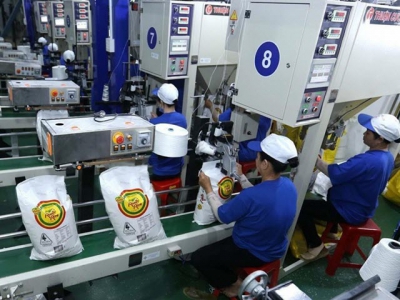Vietnamese rice exports to benefit from the EVFTA

The EU-Vietnam Free Trade Agreement (EVFTA) will provide major opportunities for Vietnamese businesses to increase rice exports if they meet European Union standards.
Great opportunities for Vietnamese rice exports to the EU under the terms of the EVFTA
According to the Ministry of Industry and Trade’s Agency of Foreign Trade, rice exports to the EU (except the UK) totaled US$10.9 million in 2019, up 92.4 percent from 2018. These relatively modest exports stem from the customs duties of 175, 65 and 211 euro per tonne that the EU imposed on Vietnamese de-husked, broken and paddy rice, respectively.
However the EVFTA sets an annual Vietnamese quota of 80,000 tonnes of rice, including 30,000 tonnes of de-husked rice, 20,000 tonnes of not-yet-de-husked rice and 30,000 tonnes of fragrant rice. Exports of broken rice are exempt from a quota. The agreement allows Vietnam to export about 100,000 tonnes of rice to the EU every year, with customs zeroes out over the next three to five years.
Pham Thai Binh, General Director of the Trung An High-tech Agriculture Joint Stock Company, said Vietnam’s rice exports to the EU were subject to very high tax rates of up to 45 percent, and some EU countries even imposed taxes of up to 100 percent or higher on Vietnamese rice. Meanwhile, Cambodian rice was exempted from tax, making Vietnamese product of the same kind less competitive. As soon as the tax is zeroed in accordance with the EVFTA, Vietnamese rice exporters will have great opportunities to increase exports and improve their products’ competitiveness.
A foot in the door
However, exporters will face major challenges, Binh said, due to the EU’s strict quality, environmental protection and business prestige standards that currently favor rice products from Thailand, Cambodia, and Myanmar. Part of the quota for Vietnamese rice is licensed for special rice varieties whose production output and cultivation areas are modest.
At a conference for exporters of produce, forest products and seafood exports to the EU, Minister of Industry and Trade Tran Tuan Anh said rice is a sensitive commodity and is produced inside the EU so getting a foot in the door for imported rice is difficult. Within the EVFTA framework, Vietnam and the EU have agreed upon types of rice and requirements for exports.
Quality is of foremost importance for Vietnamese rice exporters seeking to conquer the EU market. Products containing pesticides and/or banned substances are prohibited from entering this market. Cultivation improvement and construction of rice growing areas and production chains are important for Vietnam to develop rice exports to major markets.
The EU demand for rice is increasing significantly due to the growing popularity of Asian food. The EU consumes about 2.5 million tonnes of rice each year.
Có thể bạn quan tâm
 Mekong Delta to expand fruit, seafood production in response to climate change
Mekong Delta to expand fruit, seafood production in response to climate change The Cửu Long (Mekong) Delta plans an additional 450,000ha under fruit and seafood production by 2030
 Agro-tourism models improve farmers' income
Agro-tourism models improve farmers' income Agricultural production combined with tourism is offering higher profits for farmers in the south-central and southern provinces.
 Bà Rịa – Vũng Tàu uses origin traceability stamps on agricultural products
Bà Rịa – Vũng Tàu uses origin traceability stamps on agricultural products More agricultural products in the southern province of Bà Rịa-Vũng Tàu now have traceability stamps which improve information transparency and product value.